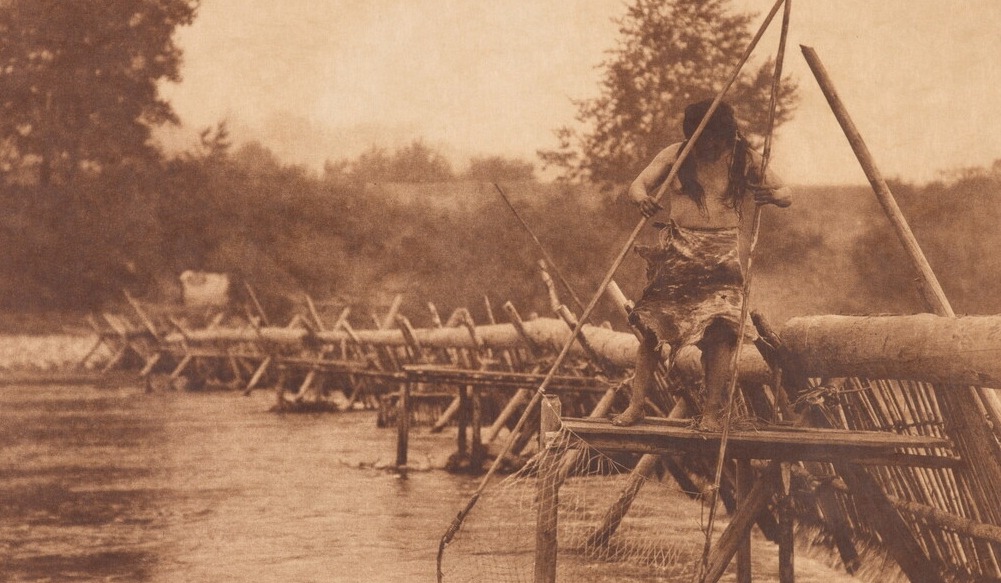Fishing has always been an economic, social, and religious staple of Pacific Northwest Indigenous life, and it became a mainstay of White economic life.
In 1792 British Captain George Vancouver described Puget Sound Natives “fishing for salmon with crude nets made of bark and young willows.” Later, American Captain Robert Gray described the smoked salmon prepared by Columbia River Natives.
Puget Sound Natives used a weir – or willow fence – placed across a stream. Tripod platforms were built nearby upon which fishermen stood with long dip nets. The salmon were scooped up as they hovered against the weir.
Columbia River Natives used nets woven of flax fibers and willow bark, with ropes of twisted cedar. Near the river’s mouth 12–100-foot reef and seine nets were employed. Fishing locations on the lower Columbia were inherited, and considered virtually private property, tribe by tribe, family by family.
Preservation of fish was mostly by drying, then they were pulverized and packed tightly into straw-lined baskets. The finished dried product was called pemican. A single basket could weigh 100 pounds, and in 1805 Lewis and Clark estimated they saw a store of 10,000 pounds of fish at The Dalles.
Spawning season was a sight to behold according to early non-Native travelers. Streams and bays were then choked with fish.
Early fur and trading companies such as the Northwest and Hudson’s Bay introduced a salting process to preserve fish. This led to an export trade of salmon and sturgeon to distant ports such as the Hawaiian Islands, Australia, China, Japan, and the eastern United States.
In 1853 the Puget Sound newspaper Columbian reported that several Euro-American families engaged in salmon fishing as a livelihood at Point Roberts, the peninsula between the United States and Western Canada.
John West invented a canning machine on the Lower Columbia and was salting salmon in barrels also in the 1850s. In 1867, S.W. Aldrich launched the territory’s first floating cannery. It carried a brick furnace and iron cauldron atop what must have been an extraordinarily seaworthy barge.
Further up the Sound, whaling enjoyed brief activity. Fish oils for export were obtained from whales, candlefish, and dogfish.
In 1881 the Columbia River mouth was lined with 35 canneries. Their total output was 550,000 cases valued at $2.5 million — a huge sum in those days. With the late 1890s and the completion of the Northern Pacific Railroad, refrigerated fresh fish was shipped to eastern markets. This activity made the Pacific Northwest fishing industry famous throughout the world.
After 1900 dramatic changes occurred in fishing and packing. In 1903, E.S. Smith patented the “Iron Chink,” so-called because it replaced diligent Asian workers often referred to in racist terms. In the same year gasoline-powered boats made their appearance and fish waste products were being used as oil or fertilizer.
About 1908 the Japanese oyster was introduced to Puget Sound waters. The sturdy and succulent bivalve thrived and has since become a “native” product and local restaurant delicacy.
This glimpse at the proud Pacific Northwest fishing industry is also a reminder of what we have lost. Dams, towns, parking lots, logging, pollution, and overfishing have contributed to the decimation of our rich and historic fish resource. And efforts to revive wild salmon never cease.
Discover more from Post Alley
Subscribe to get the latest posts sent to your email.

A very nice overview of this rich part of Northwest history. Thank you, Junius!
I believe many readers would enjoy Billy Proctor’s FULL MOON, FLOOD TIDE, -part of which provides a detailed history of how the NW fishing industry developed. It’s essential reading for all who love the British Columbia raincoast.
We can thank Japanese oysters for their piggyback parasite, the Japanese Drill, which feasted on our only native oyster, the tiny Olympia, and combined with effluent, almost brought about its extinction. By the 1970’s the Olympias had retreated to a small inlet in South Puget Sound. Since then an heroic effort has revived our native bivalve, and if we’re lucky we can enjoy it freshly shucked at our many fine oyster houses.
There is an unverified legend that Diamond Jim Brady had Olympias shipped to Delmonico’s in New York to be stuffed into Filet Mignon. As Julia Child would say, “Buon Appetite.
Salmon – our icon – Tribal, commercial, recreational.
Billions for the l”programs:” Some work, some don’t.
Best program never tried: Stop fishing for a few years.
Yay Fishing! You go Junius Rochester! Never stoop talking about fishing!